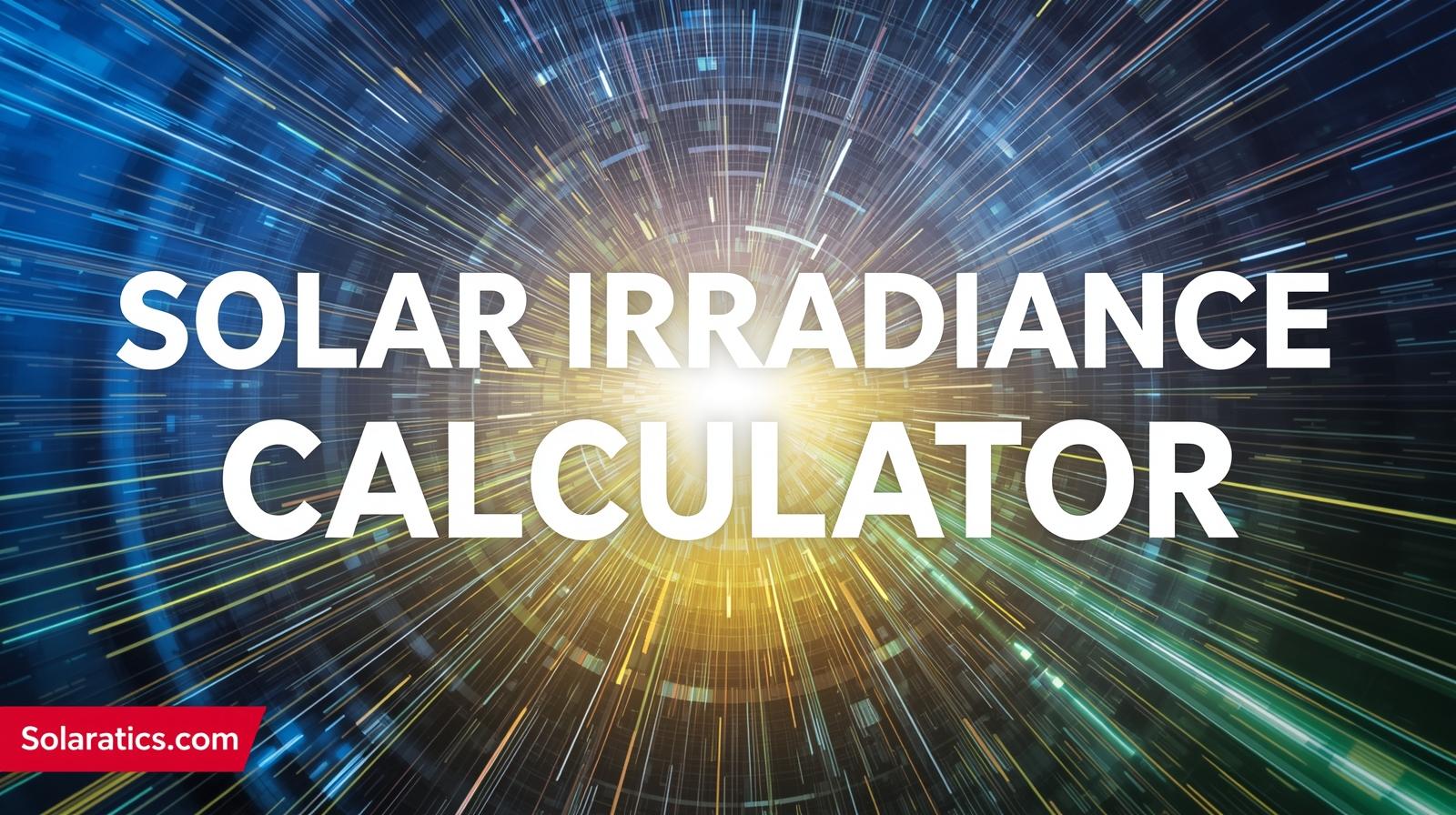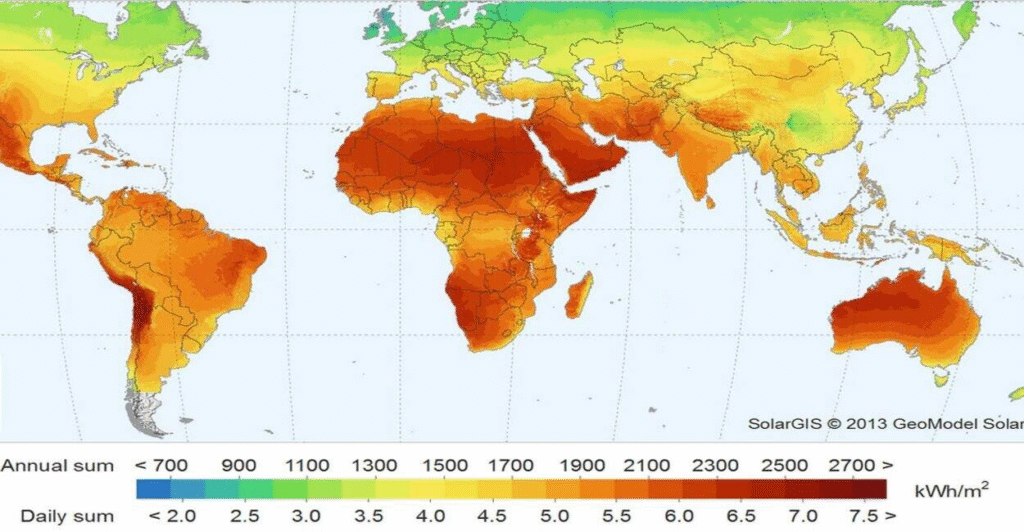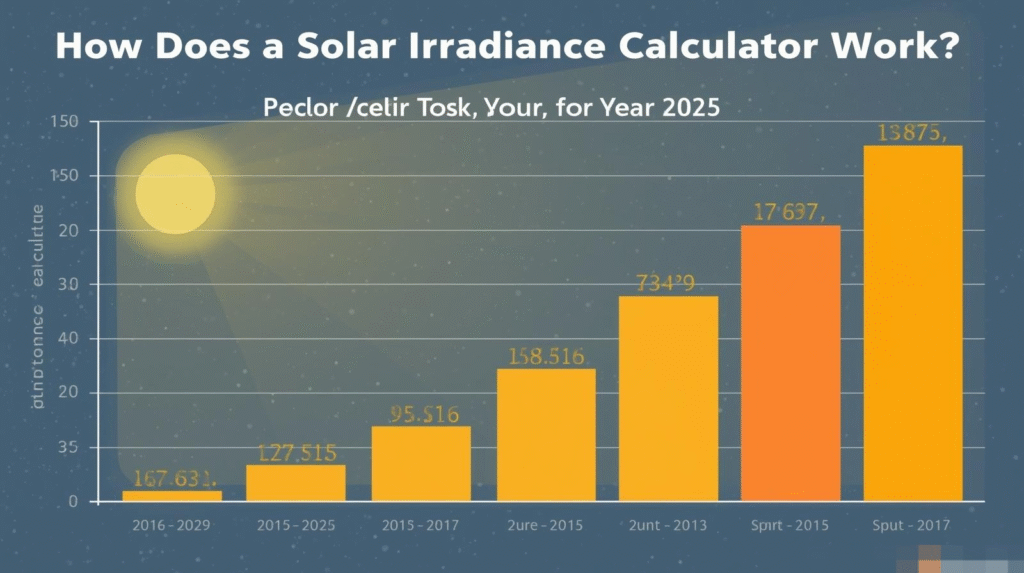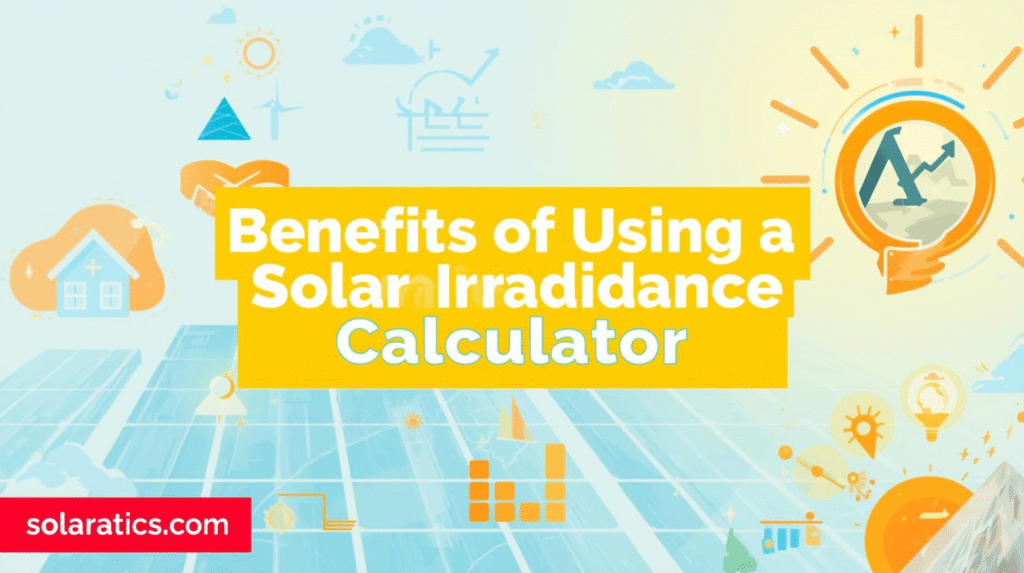Solar Irradiance Calculator | Accurate Solar Energy Guide 2025

Learn to use the solar irradiance calculator for precise solar energy estimates. Optimize your solar panel placement to save on energy costs.
Introduction:
In the search for efficient and sustainable energy solutions, accurately measuring solar irradiance—the sunlight energy received on a surface—is fundamental. A solar irradiance calculator is an essential tool that helps homeowners, solar installers, and energy experts precisely estimate the solar power available at any location. This guide explores how these calculators work, their benefits, and how they empower users to optimize solar panel performance and maximize energy output in 2025. By leveraging advanced computation techniques, modern solar irradiance calculators can rapidly provide detailed insights that were once laborious and time-consuming to obtain, making solar energy design faster, more reliable, and cost-effective. Whether you’re planning a residential solar setup or a large commercial installation, understanding solar irradiance is key to unlocking the full potential of solar power systems.
What Is Solar Irradiance And Why Does It Matter?

Solar irradiance is the amount of solar power (in watts) received per unit area (square meter) on Earth’s surface. It is a critical measure for assessing solar energy potential at any given location, informing the placement of solar panels, system sizing, and energy yield forecasting. Solar irradiance varies by geographic location, time of day, atmospheric conditions, and panel positioning.
Accurate solar irradiance calculations help homeowners, solar installers, and businesses optimize solar energy systems to maximize efficiency and ROI.
How Does a Solar Irradiance Calculator Work?

A solar irradiance calculator estimates the solar radiation available at a specific location and time based on input variables such as:
- Location (latitude, longitude, altitude)
- Date and time
- Panel tilt and azimuth (direction)
- Atmospheric factors (cloud cover, air mass)
These combined values give the total irradiance in watts per square meter (W/m²) or kilowatt-hours per square meter per day (kWh/m²/day).
Here’s how it operates in detail:
- Input Variables: The calculator requires inputs such as geographic location (latitude and longitude), date and time, solar panel tilt and azimuth (direction the panel faces), and sometimes altitude and atmospheric conditions (like cloud cover or air pollution).
- Solar Geometry Calculations: Using the date, time, and location, the calculator computes the solar angles — mainly the solar zenith angle (the angle between the sun and the vertical direction) and the solar azimuth angle (the compass direction of the sun). These angles describe the sun’s position in the sky throughout the day.
- Radiation Components Calculation: The calculator divides solar radiation into three components:
- Direct Beam Irradiance: Sunlight traveling directly from the sun to the surface.
- Diffuse Irradiance: Sunlight scattered by molecules and particles in the atmosphere reaching the surface indirectly.
- Reflected Irradiance: Sunlight reflected off surrounding surfaces onto the panel.
- Application of Atmospheric Corrections: To improve accuracy, factors like air mass (the path length sunlight takes through the atmosphere), cloud cover, and atmospheric pollution are considered, which impact how much solar radiation reaches the surface.
- Output Calculation: Using solar geometry and atmospheric data, formulas like the SARWAT formula or others, the total solar irradiance is calculated in watts per square meter (W/m²) or in energy terms like kilowatt-hours per square meter per day (kWh/m²/day).
- User Results: The calculator provides solar irradiance values that help users estimate energy generation potential for solar panels, optimize panel placement angles, and assess solar system performance.Solar irradiance calculators can be manual, based on mathematical formulas, or automated through software and online tools that rapidly perform these complex calculations using databases and models. These tools help solar designers, engineers, and homeowners maximize solar energy harvesting and system efficiency.
Using a Solar Irradiance Calculator: Step-by-Step
Step 1: Enter Your Location
Start by inputting your exact location into the calculator. This can be done by typing your city, address, or geographic coordinates (latitude and longitude). Accurate location data is crucial because solar irradiance varies significantly by geographic position due to the sun’s path and local climate conditions.
Step 2: Specify Solar Panel Tilt Angle (Optional)
If you know the tilt angle of your solar panels, enter it next. The tilt angle is the degree at which your panels are inclined from horizontal. Using the correct tilt improves the accuracy of irradiance estimates since the solar incident angle changes with tilt. If unsure, many calculators offer default angles based on location latitude or you can use a dedicated solar panel angle calculator.
Step 3: Specify Solar Panel Azimuth Angle (Optional)
Next, enter the azimuth angle, which is the compass direction your panels face. This angle is measured in degrees clockwise from true north (e.g., 180° means facing south). Properly setting azimuth helps the calculator account for directional solar radiation differences throughout the day.
Step 4: Input Date and Time (If Applicable)
Some calculators allow or require entering a specific date and time to estimate solar irradiance at that moment or for a particular day. This step helps understand temporal irradiance fluctuations.
Step 5: Click “Calculate” or Equivalent Button
Once the inputs are set, execute the calculation by clicking the relevant button. The calculator uses solar geometry formulas to determine solar angles (zenith and azimuth), and atmospheric models to adjust for air mass and other environmental factors. It then computes the expected irradiance.
Step 6: Review Your Results
The output typically includes:
- Total solar irradiance in watts per square meter (W/m²) or energy over time in kilowatt-hours per square meter per day (kWh/m²/day).
- Breakdown of direct, diffuse, and reflected irradiance components.
- Monthly or annual irradiance averages, if applicable.
Step 7: Use Results for Solar Planning
Use the calculated solar irradiance values to optimize your solar panel system design, including selection, orientation, and estimating power generation and savings.
This step-by-step process helps homeowners, technicians, and solar designers accurately assess solar energy availability tailored to specific installations and geographic locations, maximizing system efficiency and investment value.
Types of Solar Irradiance Measured
- Direct Beam Irradiance: Sunlight that reaches the panel directly.
- Diffuse Irradiance: Sunlight scattered by the atmosphere reaching the panel from all directions.
- Reflected Irradiance: Sunlight reflected from the ground or surroundings onto the panel.
Accounting for all three types yields a realistic estimate of solar energy available for conversion.
Popular Solar Irradiance Calculation Methods and Tools
| Method/Tool | Description | Accuracy | Ease of Use | Best For |
|---|---|---|---|---|
| SARWAT Formula | Advanced formula considering atmospheric and solar angles | High | Moderate | Precise solar system design |
| PVWatts Calculator | Tool from National Renewable Energy Laboratory (NREL) | Moderate to High | Easy | System energy production estimate |
| Global Solar Atlas | Interactive global solar maps with irradiance data | Moderate | Easy | Regional solar potential overview |
| Satellite-Based Data | Uses satellite measurements for irradiance estimates | Moderate to High | Easy | Tool from the National Renewable Energy Laboratory (NREL) |
| Pyranometer Measurements | Direct irradiance measurement device | Very High | Complex (equipment needed) | Validation and field data |
Benefits of Using A Solar Irradiance Calculator

- Accurate Solar Energy Estimation
A solar irradiance calculator provides precise estimates of the solar energy available at a specific location by factoring in geographic coordinates, time, and atmospheric conditions. This accuracy helps users design efficient solar energy systems tailored to actual solar potential rather than relying on generalized or outdated data. - Optimized Solar Panel Placement and Orientation
By calculating the intensity and angles of solar radiation throughout the year, these calculators help determine the best tilt and azimuth angles for solar panels. Optimized positioning maximizes - Zes sunlight capture, enhancing energy generation and improving overall system performance.
- Cost and Savings Assessment
Solar irradiance calculators aid in projecting energy output, which directly influences estimated electricity cost savings. This information helps homeowners and businesses evaluate the financial benefits of solar investments, including payback periods and return on investment (ROI), thus supporting informed decision-making. - Time and Resource Efficiency
Using irradiance calculators reduces the need for manual site visits or physical measurements. Modern software can quickly generate solar irradiance maps and detailed reports, saving solar contractors and designers valuable time and costs, particularly for complex or large-scale projects. - Improved Project Planning and Feasibility
Accurate irradiance data is vital for feasibility studies, helping stakeholders assess the viability of solar projects before implementation. This reduces risks, supports better system sizing, and ensures regulatory compliance and optimal resource allocation. - Environmental Impact Awareness
Solar irradiance calculators contribute indirectly to reducing carbon footprints and promoting sustainable energy solutions.
In short, solar irradiance calculators empower users with accurate, location-specific solar data to optimize system design, maximize energy savings, improve project efficiency, and support sustainable energy investments.
Practical Considerations in Solar Irradiance Calculations
- Accurate Input Data
Using precise location coordinates (latitude, longitude), date, and time is crucial since solar irradiance depends strongly on geographic and temporal factors. Errors in input data lead to inaccurate irradiance estimates. - Panel Orientation and Tilt
Calculations must consider the solar panel’s tilt angle and azimuth (direction). Since solar irradiance hitting a tilted surface differs significantly from a horizontal one, applying correct orientation parameters improves calculation relevance for real-world installations. - Atmospheric Conditions
Atmospheric factors such as cloud cover, humidity, dust, and pollution affect solar radiation reaching the surface. Incorporating these variables or using average meteorological data specific to the site refines irradiance accuracy. - Measurement Types – Direct, Diffuse, and Reflected Irradiance
Solar irradiance comprises direct sunlight, diffuse skylight, and reflected light from surrounding surfaces. Calculations must address these components separately and then combine them based on panel orientation for a true picture of available solar energy. - Solar Geometry Calculations
Determining solar zenith and azimuth angles for a specific date, time, and location is fundamental, as these angles influence the intensity and angle of solar rays impacting the panels. Solar position algorithms should be precise. - Temporal Resolution
Whether calculating instantaneous irradiance for a specific time or average daily/monthly values impacts model complexity. Hourly resolution offers more detail but requires more data. - Use of Appropriate Calculation Models
Different mathematical models exist for irradiance estimation. Choice depends on accuracy needs, data availability, and application scale. - Calibration and Validation
Whenever possible, validate calculated irradiance against measured data from pyranometers or PV system outputs to ensure reliability. - Environmental Variability
Consider seasonal changes, weather fluctuations, and shading effects (buildings, trees). Including these enhances prediction robustness. - Data Quality and Updates
Regularly update input meteorological data and revisit assumptions to maintain calculation accuracy over time.
Considering these practical points ensures solar irradiance calculations are accurate, reliable, and applicable for solar energy planning and optimization.
Conclusion
Using a solar irradiance calculator is essential for anyone planning to harness solar energy efficiently in 2025. These tools integrate geographic, atmospheric, and solar position data to provide accurate estimates that guide solar panel installation and optimize energy output. Selecting the right calculator and understanding irradiance types ensures maximum solar investment value and supports sustainable energy goals.
FAQs
Solar irradiance depends on location, time of day, atmospheric conditions, and solar panel tilt and orientation. Seasonal variation and shading also impact it.
Yes, most modern solar irradiance calculators use global data and solar geometry principles to provide results anywhere on Earth.
Accuracy varies by tool and inputs; tools like PVWatts provide moderate to high accuracy, especially when precise local data is included.
Solar irradiance is instantaneous solar power received per unit area (W/m²), while solar insolation is the total solar energy received over a period, often daily (kWh/m²/day).
Many online calculators like PVWatts and Global Solar Atlas are free, offering easy access to solar radiation data for various locations.
